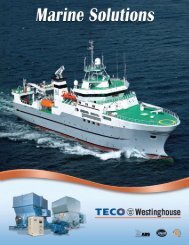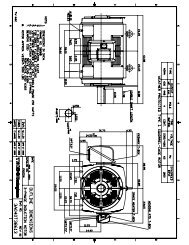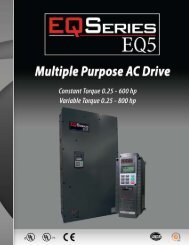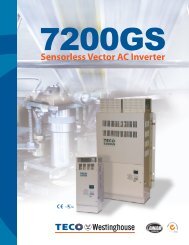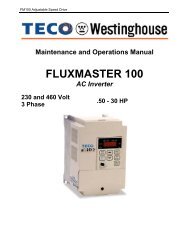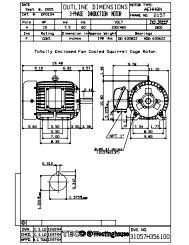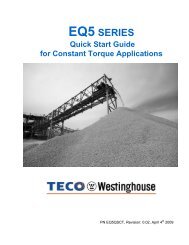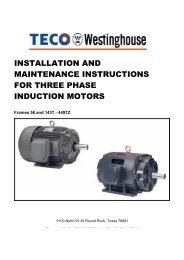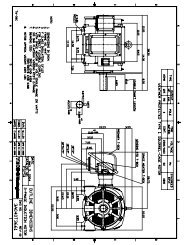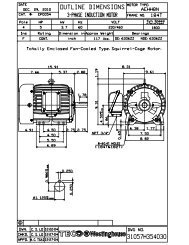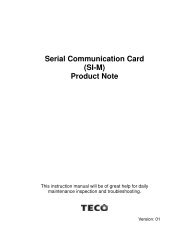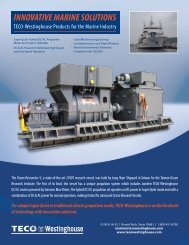EQ7 Series Instruction Manual - TECO-Westinghouse Motor Company
EQ7 Series Instruction Manual - TECO-Westinghouse Motor Company
EQ7 Series Instruction Manual - TECO-Westinghouse Motor Company
Create successful ePaper yourself
Turn your PDF publications into a flip-book with our unique Google optimized e-Paper software.
P09 to P11 <strong>Motor</strong> 1 (Slip compensation gain for driving, Slip compensation response time, and<br />
Slip compensation gain for braking)<br />
P09 and P11 determine the slip compensation amount in % for driving and braking individually and adjust the slip<br />
amount from internal calculation. Specification of 100% fully compensates for the rated slip of the motor.<br />
Excessive compensation (P09, P11 100%) may cause hunting (undesirable oscillation of the system), so<br />
carefully check the operation on the actual machine.<br />
P10 determines the response time for slip compensation. Basically, there is no need to modify the default setting.<br />
If you need to modify it, consult your <strong>TECO</strong>-<strong>Westinghouse</strong> <strong>Motor</strong> <strong>Company</strong> representatives.<br />
P09<br />
P11<br />
P10<br />
Function codes<br />
Slip compensation gain for<br />
driving<br />
Slip compensation gain for<br />
braking<br />
Slip compensation response<br />
time<br />
Operation (Slip compensation)<br />
Adjust the slip compensation amount for driving.<br />
Slip compensation amount for driving =<br />
Rated slip x Slip compensation gain for driving<br />
Adjust the slip compensation amount for braking.<br />
Slip compensation amount for braking =<br />
Rated slip x Slip compensation gain for braking<br />
Specify the slip compensation response time. Basically,<br />
there is no need to modify the default setting.<br />
For details about the slip compensation control, refer to the description of F42.<br />
P12<br />
<strong>Motor</strong> 1 (Rated slip frequency)<br />
P12 specifies rated slip frequency. Obtain the appropriate values from the test report of the motor or by calling the<br />
manufacturer of the motor. Performing auto-tuning automatically sets these parameters.<br />
• Rated slip frequency: Convert the value obtained from the motor manufacturer to Hz using the following<br />
expression and enter the converted value. (Note: The motor rating given on the nameplate<br />
sometimes shows a larger value.)<br />
(Synchronous speed - Rated<br />
Rated slip frequency (Hz) =<br />
speed)<br />
Base frequency<br />
Synchronous speed<br />
For details about the slip compensation control, refer to the description of F42.<br />
P13 to P15 <strong>Motor</strong> 1 (Iron loss factors 1 to 3)<br />
P13 to P15 compensates the iron loss caused inside the motor under vector control with speed sensor, in order to<br />
improve the torque control accuracy.<br />
The combination of P99 (<strong>Motor</strong> 1 selection) and P02 (<strong>Motor</strong> 1 rated capacity) data determines the standard value.<br />
Basically, there is no need to modify the setting.<br />
P16 to P20<br />
P21 to P23<br />
<strong>Motor</strong> 1 (Magnetic saturation factors 1 to 5)<br />
<strong>Motor</strong> 1 (Magnetic saturation extension factors "a" to "c")<br />
These function codes specify the characteristics of the exciting current to generate magnetic flux inside the motor<br />
and the characteristics of the magnetic flux generated.<br />
The combination of P99 (<strong>Motor</strong> 1 selection) and P02 (<strong>Motor</strong> 1 rated capacity) data determines the standard value.<br />
Performing auto-tuning while the motor is rotating (P04 = 2 or 3) specifies these factors automatically.<br />
4-112



